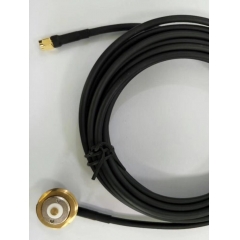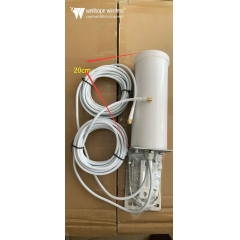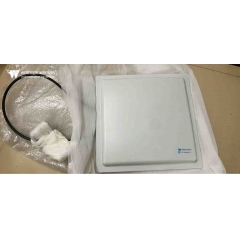เกี่ยวกับ dB, dBm และ dBi
ใช้เวลาประมาณ 15 นาทีจึงจะอ่านจบ
ดีบี (เดซิเบล)
DB เป็นหน่วยสัมพัทธ์ที่ใช้เพื่อแสดงอัตราส่วนระหว่างปริมาณสองปริมาณ มักใช้เพื่ออธิบายอัตราส่วนของกำลังหรือแรงดันไฟฟ้า (หรือกระแสไฟฟ้า)
คำจำกัดความ: (dB=10 \ log_ {10} \ left (\ frac {P_2} {P_1} \ right)) หรือ (dB=20 \ log_ {10} \ left (\ frac {V_2} {V_1} \ right) )
ในจำนวนนั้น (P_1) และ (P_2) คือค่ากำลังสองค่า และ (V_1) และ (V_2) คือค่าแรงดันหรือกระแสสองค่า
หมายเหตุ: dB เป็นหน่วยสัมพัทธ์ที่แสดงอัตราส่วนระหว่างปริมาณสองปริมาณ ไม่ใช่ค่าสัมบูรณ์
1. สูตรคำนวณเดซิเบลสำหรับอัตราส่วนกำลัง:
เมื่อเปรียบเทียบค่ากำลังสองค่า สูตรคำนวณเดซิเบลคือ:
DB=10log10 (P1P2) โดยที่ (P_1) คือกำลังอ้างอิง (โดยปกติจะเป็นค่าคงที่) และ (P_2) คือกำลังที่จะวัด หาก (P_1) คือ 1 วัตต์ สูตรข้างต้นสามารถสรุปได้เป็น: dB=10log10 (P2) โดยที่ (P_2) คือค่ากำลังในหน่วยวัตต์
2. สูตรคำนวณเดซิเบลสำหรับอัตราส่วนแรงดัน (หรือกระแส):
เมื่อเปรียบเทียบค่าแรงดันไฟฟ้า (หรือกระแส) สองค่า สูตรการคำนวณเดซิเบลคือ:
เดซิเบล=20log10(V1V2)
บางที
เดซิเบล=20log10(I1I2)
ในจำนวนนั้น (V_1) และ (I_1) คือแรงดันและกระแสอ้างอิง (โดยปกติจะเป็นค่าคงที่) ในขณะที่ (V_2) และ (I_2) คือแรงดันและกระแสที่จะวัด ถ้า (V_1) หรือ (I_1) คือ 1 โวลต์หรือ 1 แอมแปร์ สูตรข้างต้นสามารถสรุปได้ดังนี้:
เดซิเบล=20log10(V2)
บางที
เดซิเบล=20log10(I2)
Here (V_2) and (I_2) are voltage and current values in volts or amperes.
Note: In these formulas, (\ log_ {10}) represents the logarithm based on 10. If (P_2/P_1) or (V_2/V_1) (or (I_2/I_1)) is greater than 1, then the decibel value is positive; If it is less than 1, the decibel value is negative. The larger the decibel value, the greater the multiple of (P_2) relative to (P_1) (or (V_2) relative to (V_1), or (I_2) relative to (I_1)).

DBm (decibels milliwatts)
DBm is an absolute unit used to represent power values, with a reference point of 1 milliwatt (0.001 watt).
Definition: (dBm=10 \ log_ {10} \ left (\ frac {P} {1mW} \ right))
Where (P) is the power value to be measured.
For example, if the power of a signal is 1 watt, then its power is (10 \ log_ {10} (1000)=30 dBm).
DBm is commonly used to describe the power of wireless signals or the sensitivity of receivers.
DBm calculation formula
dBm=10log10(1mWP)
Among them,
(P) is the power value to be measured, in milliwatts (mW).
(1mW) is the reference power value, which corresponds to the power of 0dBm.
Related information
1. Unit conversion:
0dBm corresponds to 1 milliwatt (1mW).
For every 3dBm increase, the power doubles; For every reduction of 3dBm, the power is halved.
For example, 30dBm corresponds to 1 watt (1W), because (10 \ log_ {10} (1000)=30) (because 1W=1000mW).
2. Common conversion values:
o 30dBm = 1W
o 40dBm = 10W
o 50dBm = 100W
3. Precautions:
DBm represents the absolute value of power, not the power ratio.
In the calculation, pay attention to the unit of power and ensure that it is consistent with the unit of reference power (1mW).
Example
If the power of a signal is 4 watts (4W), then its power (in dBm) can be calculated as follows:
dBm=10log10(1mW4000mW)=10log10(4000)=10*(3+log10(4))≈36.02dBm
(Here (\ log_ {10} (4) \ approx 0.602) is the base 10 logarithm of 4)
DBi (decibels relative to isotropy)
DBi is a unit used to describe antenna gain, with its reference point being an idealized isotropic antenna (i.e. an antenna that uniformly radiates or receives in all directions).
Definition: (dBi=10 \ log_ {10} \ left (\ frac {G} {G_ {iso}} \ right))
Among them, (G) is the gain of the antenna to be measured, and (G_ {iso}) is the gain of an isotropic antenna (theoretically 1).
Note that since isotropic antennas do not exist in reality, dBi is a relative unit, but it provides a convenient reference point to compare the gains of different antennas.
DBi is commonly used to describe the gain of antennas used in wireless communication.
DBi calculation formula
dBi=10log10(E0E)
Among them:
(E) is the effective radiation power or gain of the actual antenna.
(E0) is the effective radiation power or gain of an ideal isotropic antenna. An ideal omnidirectional antenna has uniform radiation in all directions, and there is no such antenna in practice, so it serves as a reference benchmark.
Related information
1. เกณฑ์มาตรฐานอ้างอิง: เกณฑ์มาตรฐานอ้างอิงสำหรับ dBi คือเสาอากาศรอบทิศทาง ซึ่งเป็นแบบจำลองในอุดมคติทางทฤษฎีที่ใช้ในการเปรียบเทียบอัตราขยายของเสาอากาศอื่นๆ
2. ความสัมพันธ์กับ dBd: dBi และ dBd เป็นหน่วยที่อธิบายอัตราขยายของเสาอากาศ แต่มาตรฐานอ้างอิงต่างกัน เกณฑ์มาตรฐานอ้างอิงสำหรับ dBi คือเสาอากาศรอบทิศทาง ในขณะที่เกณฑ์มาตรฐานอ้างอิงสำหรับ dBd คือ เสาอากาศ แบบไดโพล
(เสาอากาศไดโพล). เป็นที่เชื่อกันโดยทั่วไปว่าเมื่อแสดงถึงกำไรที่เท่ากัน ค่าที่แสดงโดย dBi จะมากกว่าค่าที่แสดงโดย dBd 2.15 (เช่น dBi=dBd+2.15)
3. ตัวอย่าง: หากอัตราขยายของเสาอากาศแสดงเป็น 16dBd ใน dBd อัตราขยายจะแสดงเป็น 18.15dBi ใน dBi (โดยปกติแล้วจะไม่สนใจตำแหน่งทศนิยม ซึ่งก็คือ 18dBi)
โดยสรุป dBi เป็นหน่วยที่ใช้อธิบายอัตราขยายของเสาอากาศ และสูตรการคำนวณจะขึ้นอยู่กับอัตราส่วนของพลังงานรังสีที่มีประสิทธิผลของเสาอากาศจริงต่อพลังงานรังสีที่มีประสิทธิผลของเสา อากาศรอบทิศทางในอุดมคติ เมื่อเปรียบเทียบกับ dBd แล้ว การอ้างอิงของ dBi จะเป็นเสาอากาศรอบทิศทาง ดังนั้นเมื่อแสดงถึงเกนที่เท่ากัน ค่าของ dBi จะมากกว่าค่าของ dBd ถึง 2.15


















 MIMO เสาอากาศ
MIMO เสาอากาศ
















